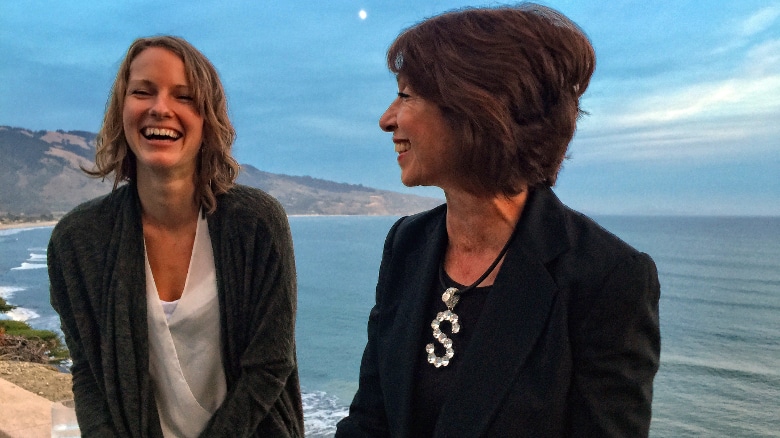Photos: Sean Hellfritsch
Kaitlyn Aurelia Smith and Suzanne Ciani come from very different generations, but if that’s one thing that unites the two composers it’s their preferred instrument. The Buchla was developed at the same time when Robert Moog started producing the synthesizer that would be introduced to the world through a curious but nonetheless immensly successful record, Wendy Carlos’ Switched-On Bach. Two synthesizers, two different philosophies: While the Moog tried to convey the feel and practicality of a keyboard-based instrument, the Buchla was a completely new instrument intended for completely new music. Ciani has been playing it for literally decades while Smith has recently received a lot of attention for her unique blend of Jazz sentiments, crisp electronic soundscapes and Pop structures. The two have teamed up for the album Sunergy, which is out today on RVNG Intl as part of the FRKWYS series. Groove writer Christin Bolte caught up with them to talk their fascination with the Buchla, their working methods and why you can’t only have carrots on your plate.
Over the past years, modular synthesizers have become fashionable again. How do you feel about this? There is so much interest in both of your work right now. How do you perceive this as a musician?
Suzanne Ciani: Kaytlin and me we are different generations, you know. So it is very-very interesting I think. In a way I see myself a little bit in Kaytlin. When I was Kaytlin’s age and doing modular synthesis there was no outlet for it. It was very isolated, not a lot happening. Now this time around it is very exciting to watch that it has re-invented itself in a popular way and I hope this potential of this modular world is reached now. And it is. It is very exciting. Because the modular took a left turn. People went into keyboard synthesizers for many years. I never thought this would come back and I am very excited to see it all happening again.
Kaytlin Aurelia Smith: When I first started playing modulars I was living on an island and I actually did not know that there were other people who played modulars. And when I was researching while I was learning you know I discovered Suzanne’s music and Morton Subotnick’s. But it still did not know about your record (Ciani’s Seven Waves from 1982) until two years ago. I still have not really tipped my toes into that world but it is very interesting as I have been more efficient and discovered more musicians. Finding out that a lot have been played modulars the past 15 years or so and that it is just starting to become focal point in the music world.
Speaking from a technical perspective, what do you think makes the modular synthesizer interesting to musicians today?
SC: For me having watched a lot of music production going into the computer world… you know where you are controlling your interface with a mouse. I think that was very unsatisfactory and I think the new generation craved what we had in the old days. Which was hands-on. An actual physical interface interaction. You know, turning knobs, moving files, patching patches.
KS: I agree with that sentiment. Having a tactile interface. And I think it is very empowering to a lot of musicians with this DIY movement that is also getting more popular over the past twenty years. And people are feeling more that they are able to have access to open source schematics to be able to make their own modules and to create their own instruments.
Video: Sunergy (Documentary)
Kaitlyn, Amongst many others, Arduino or MAX MSP provide a digital solution to create your own instruments for programming music. Do you use digital instruments, too?
KS: I do. I combine both of them.
What in your work is the specific use of the digital and the analogue instruments?
KS: I personally tend to use analogue voices but I like to use a lot of digital processors because they feel like very beefy and they keep up with a lot of tasks, like digital sequencers and samplers. And you, Suzanne?
SC: I am going back to reconnect with my 60s and 70s persona. In that period of time I was a hundred per cent dedicated to the Buchla. I had also done computer music at Standford and I studied with John Chowning. I had experience with the early computer music and then I spend many years in a combined world. Using the Synclavier and doing a lot of things digitally. But now I am coming back for some reason. MI am still very committed to focussing on that one instrument. I am using a lot of digital processors in another identity for recording and digital processing but for my live performance now I consider myself a Buchla player.

In both of your electronic music biographies the Buchla was a kind of initiation. What makes it special to you and kept you stick to the Buchla?
KS: I felt like there is a lot of feedback and so it feels like there is a lot of interplay with the Buchla instruments and modular synthesis in general. There is a lot of interplay between the instrument and the player mostly because a lot of the components are not as stable as digital synthesis. You are constantly working with each other. And that feels exciting and harmonically really rich.
SC: I was intimately involved with the early years of the instrument and I really felt that Buchla’s vision was unique and his embracing of the concept of a performance instrument. And some don’t think about it as this. I was surprised speaking with Morton Subotnick, who is one of the very early generative musicians with Buchla. Morton never thought about it as a performance instrument! He thought of it as: you make a good sound, you record it, then you make another sound, you record it. And I thought, gee, this is strange! By the time I met Buchla, which is maybe for or five years later, Don had already evolved into this new vision of making a performance instrument and that was always my shared vision with him. That it was a performance instrument.
What is your fascination of the Buchla as a live performance instrument?
SC: It is not easy to perform. It will really take all the dedication you can give it. It is not a shallow instrument, it is deep. It is really engaging. For me coming back to it at this state – you know, my brain is not as elastic like it was when I was in my twenties – it is more of a challenge to handle a hundred things in the same second. But I do love it and I think that is unique that way.
On the next page: Ciani compares Techno to carrots.





